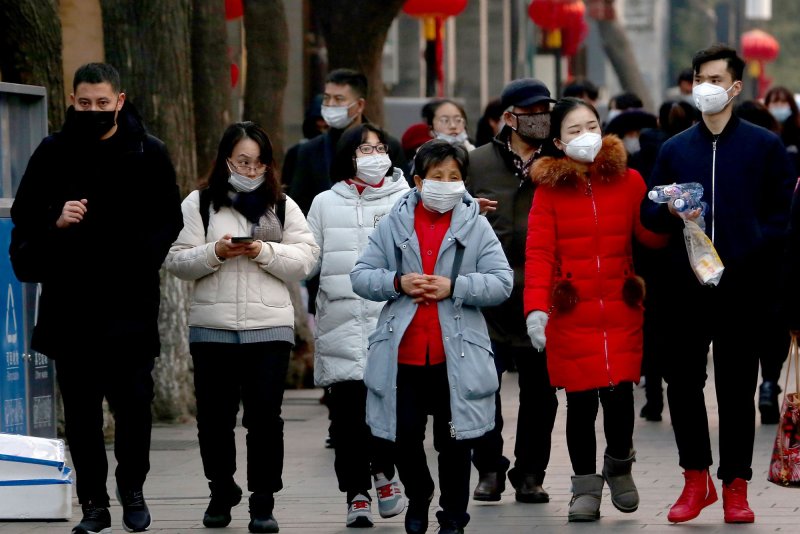People in China wear protective respiratory masks in Beijing on Saturday, January 25, 2020. New analysis suggests far more people have been infected with 2019-nCoV than reported because some are asymptomatic and others may not seek medical attention. Photo by Stephen Shaver/UPI |
License Photo
Jan. 31 (UPI) -- More than 75,000 people in the city of Wuhan, China may have been infected with the 2019 novel coronavirus, a new analysis suggests.
The findings, published Friday in the journal The Lancet, are based on epidemiologic modeling of 2019 n-CoV and its spread.
Researchers caution that, given the lack of a robust and detailed timeline of records of suspected, probable and confirmed cases of the disease, as well as information on the close contacts of those infected, the true size of the epidemic and its pandemic potential remains unclear.
"Not everyone who is infected with 2019-nCoV would require or seek medical attention," study co-author Gabriel Leung, of the University of Hong Kong, said in a statement. "During the urgent demands of a rapidly expanding epidemic of a completely new virus, especially when system capacity is getting overwhelmed, some of those infected may be under-counted in the official register."
Wuhan, a city of 11 million, is ground zero for the virus. To date, Chinese officials have confirmed nearly 10,000 cases of the disease across the entire country.
In their analysis, Leung and his colleagues used mathematical modelling to estimate the size of the epidemic based on officially reported 2019-nCoV case data and domestic and international travel data. They assumed that the serial interval estimate -- or the time it takes for infected individuals to infect other people -- for 2019-nCoV was the same as for severe acute respiratory syndrome, or SARS.
They also also modeled potential future spread of 2019-nCoV in China and internationally, taking into account the potential impact of various public health interventions that were implemented in January 2020. The measures include the use of face masks and increased personal hygiene as well as the quarantine measures introduced in Wuhan on January 23.
The results suggest that in the early stages of the Wuhan outbreak, from Dec. 1 to Jan. 25, each person infected with 2019-nCoV could have infected up to three other individuals on average, and that the epidemic doubled in size every 6.4 days. This translates to up to 75,815 individuals potentially being infected in Wuhan during the 56-day period.
"The apparent discrepancy between our modeled estimates of 2019-nCoV infections and the actual number of confirmed cases in Wuhan could also be due to several other factors," Leung said. "These include that there is a time lag between infection and symptom onset, delays in infected persons coming to medical attention, and time taken to confirm cases by laboratory testing, which could all affect overall recording and reporting."
The findings indicate that cases of 2019-nCoV infection may have spread from Wuhan to multiple other major Chinese cities as of January 25, including Guangzhou, with 111 cases; Beijing, with 113; Shanghai, with 98; and Shenzhen, with 80. In all, these cities account for over half of all outbound international air travel from China, the researchers point out.
While the estimates suggest the quarantine in Wuhan may not have completely halted the epidemic, further analysis suggests that if officials can reduce transmissibility by 25 percent in all cities nationally, the growth rate and the size of local epidemics could be substantially reduced.
A 50 percent reduction in transmissibility could shift the current 2019-nCoV epidemic from one that is expanding rapidly, to one that is slowly growing, the authors say.
"Based on our estimates, we would strongly urge authorities worldwide that preparedness plans and mitigation interventions should be readied for quick deployment, including securing supplies of test reagents, drugs, personal protective equipment, hospital supplies, and above all human resources, especially in cities with close ties with Wuhan and other major Chinese cities," Leung said.















